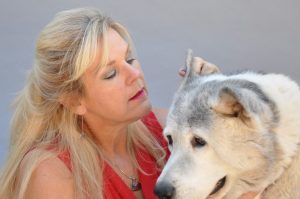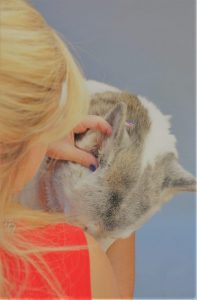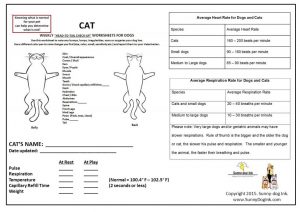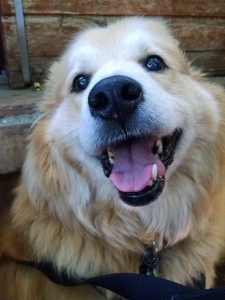 Getting acquainted with a pet’s body and habits can help you detect problems early. A weekly Head-to-Tail Check-up is easy to learn and can help you bond with your canine, feline or any best friend or client.
Getting acquainted with a pet’s body and habits can help you detect problems early. A weekly Head-to-Tail Check-up is easy to learn and can help you bond with your canine, feline or any best friend or client.
Really Get to Know the Animals in Your Care
In the wild, it is in an animal’s best interest not to let on when they are injured or ill, so this mentality carries over too many domestic critters as well, especially in multi-pet households where no one wants to lose his place in the hierarchy. Since pets don’t tell us when something is wrong, we must regularly take a good look and feel to determine if something is not quite right. By detecting a problem early, YOU can truly become a super hero in the life of an animal!
According to Sid Shapiro of Upstate New York, “While doing our weekly Head-to-Tail Check we learned in a Sunny-dog Ink Pet First-Aid Class, my boyfriend and I found a lump on our ten-year-old Dachshund Dreyfuss. At the Vet’s office, Dreyfuss was a champ when the doctor started poking around since he was so used to us checking him regularly. Two surgeries and three hospital stays later, our Doxie is healthy and cancer-free, but it may not have been possible if we hadn’t discovered that lump months before he was due for his annual exam.”
When to Begin
When you’re a professional pet sitter, your human clients think you are an ‘animal everything!’ So teach them to get their dogs and cats to give over their paws as soon as they acquire them. When you visit, work on this as well so that toes, paws and all body parts can be examined and nails easily clipped. Remind clients to take time to carefully accustom their pets to fingers in the mouth. This will enable them and YOU to brush teeth, remove unwanted items and check the color of his gums which are an important indicator of health.
 Where to Begin
Where to Begin
Gently clean ears of dirt and waxy debris with ear wash on a soft cloth (1/2 purified water & 1/2 cider or white vinegar works well as does cooled chamomile or green tea with nothing added). If you notice redness, a foul odor or what looks like coffee grounds, suggest a veterinary visit as these could be the signs of a yeast or fungal infection or the presence of ear mites.
If eyes water excessively, have a thick discharge or if the dog or cat is rubbing at them, clean with saline solution or purified water by lifting the upper eyelid and flushing from the outer corner so that fluid and debris run towards the muzzle. If still a problem, take dog on leash or kitty wrapped in a towel, safely into the bright sunlight. “A corneal lesion will cause severe squinting of the affected eye,” according to Burbank, California Veterinarian Martin Small. “Keep pet in a dark room until you can get him to the vet as darkness will lessen pain as the eye dilates.”
Compare animal eyes for any differences making sure both pupils (dark round centers on dogs/vertical slits on cats) are of equal size. When they are not, the condition is called anisocoric and the pet needs prompt medical attention. Nervous system abnormalities, as well as infection, inflammation, cancer or trauma can cause this condition. Barbara Davis of Tucson, Arizona, discovered her three-year-old Rottweiler’s pupils were unequally dilated and rushed him to the vet. The dog had ingested poisonous seed pods of the Golden Rain Tree (Cytisus Laburnum) but Davis’ quick attention saved the day.
As you continue your Head-to-Tail Check, feel the nose or muzzle for bumps and tenderness. Due to bone and cartilage in the snout, it may be impossible to feel a growth, but if it seems tender to the touch or there is an unusual discharge from the nostrils, suggest a veterinary visit.
Next, have your furry friend ‘open wide.’ Gums should be a healthy pink (except for those cats with black gums and Chows or Black Labs) with no bad odor coming from the mouth. An unpleasant scent could mean gum disease, tooth decay or gastrointestinal problems while sweetness or an acetone-like scent, could signal diabetes, so alert the pet’s parent. Assess capillary refill time (circulation) by pressing your index finger on the gum line to lighten the area. When you release pressure, color should return in 1-2 seconds on a healthy pet, but blue, grey or pale gums are also of great concern and require immediate medical attention! Check hydration by feeling the moistness of the gums. Sloppy wet = Good! But if dry or sticky, encourage pet to drink or give water with an eyedropper. If pet is lethargic, skin sticks together and/or eyes are sunken…high tail it to veterinary care! Pets are 70% water and need to have a good healthy supply at all times.
 All-Over Massage
All-Over Massage
As you complete the head check, the rest of your exam should be a gentle massage looking and feeling for things that don’t belong — abrasions, bumps, tenderness and sores; even parasites, burrs and foxtails that may have found their way onto a furry coat. When you reach the chest, you should be able to feel, but not see, the ribs (unless it’s a Greyhound, Whippet, Ibizan, Rhodesian Ridgeback or similar super lean breed). Breathing should be steady and between 20-40 breaths per minute; 10-30 for older dogs and large breeds.
Inspect legs and paws making sure pads are not cracked and nails are trimmed. Be gentle and go the speed that is comfortable for the pet doing this when you are in a good frame of mind yourself. Together you can enjoy this bonding experience and wellness check.
Kate Ahrens of Grand County, Colorado, was looking over her dog Bubba when the little guy screamed as she stretched his thigh – something she normally did without issue. After a trip to her emergency veterinarian, it was determined that Bubba had a ruptured disc. “My veterinarian said that if I hadn’t discovered his pain, it could have been several more days before he exhibited signs delaying the help he needed,” says Ahrens.
With your fingertips, next stroke the dog or cat’s abdomen making sure there are no hard spots or sensitive areas. Check mammary glands, genitals and “under the tail” — all should be clean with no colored discharge. If animal is older or arthritic and can’t perform his own hygiene, help keep him clean with a warm wet cloth. If you notice scooting or impacted anal glands, suggest a visit to the vet or groomer for assistance unless you are adept at expressing them yourself.
Keep records for each pet you care for using the forms below. Dog and cat pulses can be palpated by feeling the Femoral Artery inside the thigh. Medium to large dogs should have a pulse of 60-90 while small dogs range between 90-160 and cats as high as 200 beats per minute. Then long or short, fluffy or hairless, the animal’s tail too should be examined for bumps and sores remembering that the area right above often harbors parasites. Quick Tip: If you don’t notice fleas but find flea dirt, empty the flea comb onto a damp paper towel. If the towel turns pink, that’s dried blood from the pet, so fleas are present.

Throughout your assessment, notice the skin and coat for flaking or excessive shedding. The right brush can feel like a massage and help stimulate oil glands. If you notice anything that is not quite right, suggest that the pet’s parents contact their veterinarian for his professional opinion. Never diagnose, but express that you feel something is out of the norm and should be addressed.

Final Steps
Conclude your head-to-tail check-up with a game of ball, a belly rub or a healthy treat and take note of habits as well: How often must water bowl be refilled or litter box cleaned? Does pet leaning to the side as he walks or sits or labor getting up or down? Anything unusual could be a symptom.
Additionally, know the location of all Animal Emergency Hospitals in the neighborhoods you service as well as nearby parks or other places you take pets. Get down on all fours to keep dangers out of paws and claws reach, but also be prepared to handle what life throws your way by having tools (Pet First-Aid Kit), the knowledge to cope with every situation (Pet First-Aid Skills).
The 3 most important things you should look for when doing a Head-to-Tail Check-up are:
1) Condition of the Coat
A sick pet may not be up to keeping himself well-groomed. A stinky oily coat can be caused by several ailments that only your veterinarian can determine for sure – it could be an indication of low thyroid or even seborrhea which can be caused by flea or food allergies and even pancreatitis.
2) Body/Muscle Mass
By getting familiar with the “feel” of the dogs and cats in your care, you can evaluate weight gain or loss as well as locate masses, tumors, bruises and wounds that might otherwise remain hidden.
3) Color of Mucus Membranes
You want to see “bubble gum” pink color in a pet’s mouth, although some animals have darker or splotchy gums which are normal for them. Knowing their proper color can determine sufficient circulation, red blood count, and hydration.
Signs that Fluffy or Fido should visit the vet include:
Loss of Appetite
Difficulty Breathing or Excessive Panting
Rapid or Decreased Heart Rate
Pulmonary and/or Cardiac Arrest
Shock
Tenderness, Redness, Swelling or Open Sores
Bleeding or unusual discharge from any orifice or wound
Frequent or Infrequent Urination
Vomiting/Diarrhea/Constipation
Restlessness or Lethargy
Inability to walk
Distended Abdomen
And if you share your life with other species, be sure to check out my classes and books on birds, rabbits and pocket pets at www.PetSafetyCrusader.com/products/classes
For 20 years Denise Fleck’s Sunny-dog Ink motto has been “Helping people to help their pets,” and she has…personally having taught close to 20,000 pet lovers animal life-saving skills and millions more on “The Doctors,” CNN, “Kirstie Alley’s Big Life,” Animal Planet and other TV shows. Denise is a frequent conference speaker, developed a line of pet first aid kits, written a dozen books and now offers classes online.
Note: The articles on this page are copyrighted. Please do not reprint or use portions for any purpose without written permission from the author. Request permission for usage by sending an email explaining how you’d like to use the materials and what parts specifically. Thank you in advance!








